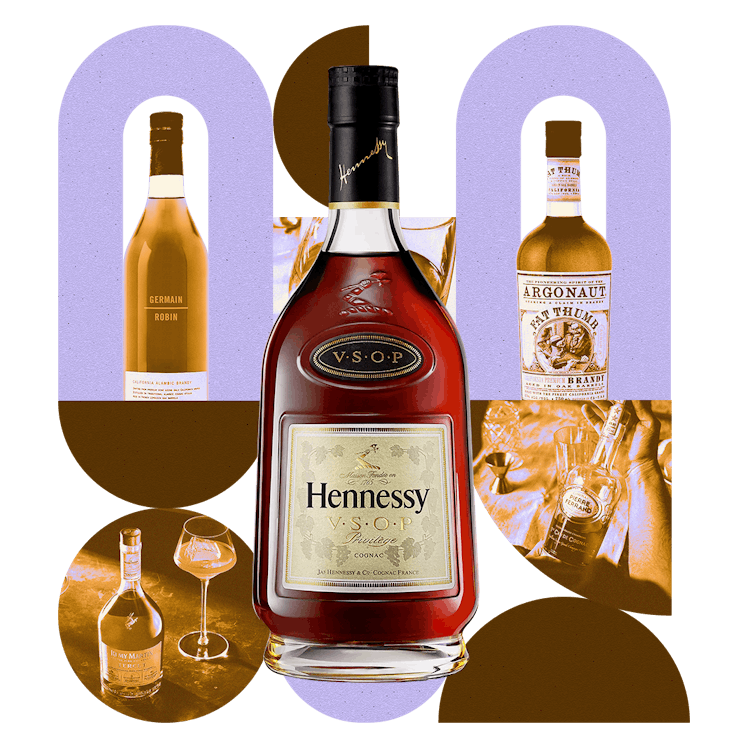The Best Brandy For Bourbon Lovers, Cocktails Fans, And Winter Sipping
Brandy is a broad, nuanced category of spirits worth exploring — especially in the colder months. These are some excellent bottles to know.

Chances are you’ve heard of Hennessy. And you might have a dusty bottle of Rémy Martin in the liquor cabinet that you break out for the holidays. But brandy is a rich category of spirit with a lot of variety and plenty of innovation happening that deserves a harder look. Whether you are a bourbon lover who appreciates similar-tasting spirits (Armagnac is for you), want to jazz up your cocktails, or simply want a special-occasion, fortifying drink to sip by the fire this winter, the category is well-worth exploring.
Any spirit distilled from fruit or fruit derivatives is a brandy. The word itself is derived from the Dutch word for ‘burnt wine,’ though beyond grapes it also includes any spirits made from apples, pears, peaches, plums, oranges, cherries –– literally any fruit.
Our list here is focused on brandies with a base of wine or cider, made from France and California: a country where Cognac, Armagnac, and Calvados showcase expressions of brandy rooted in deep tradition, and a state where old traditions and new innovations are being blended to push the boundaries of what a brandy can be.
If you’re new to brandy, it’s the original fine spirit. The booze of kings. And if you like fine rums or rare Bourbon, you’ll find familiar pleasures in exploring brandy. But what makes brandy even better is that some regions are relatively undiscovered by the global market, so, for example, you can buy an exquisite bottle of Armagnac for the price of an average bottle of Bourbon.
If you want to sip old brandies, like an X.O. Cognac, you’re going to want to sip it neat in a snifter or a wine glass, both of which allow the heat of your hand to warm the glass and release the aromas. With younger brandies, you can enjoy them on the rocks or mix them in cocktails.
Here, then, are seven great bottles of brandy to know.
Cognac
All Cognacs are brandies, but not all brandies are Cognacs. Cognac is the global gold standard of brandy and has the oldest and richest legacy of any fine spirit in the world. It’s made from white grapes that are low in sugar and high in acidity which grow well in the chalky soils of the region, primarily a grape called Ugni Blanc.
Cognac is distilled twice in copper pot stills, aged in French Oak barrels for at least two years, and then blended after aging. These blends are categorized by the minimum age of the spirits used: two years for VS (very special), four years for VSOP (very superior old pale), and ten years for XO (extra old).
Armagnac
Brandy production in Armagnac is older than that of Cognac, despite the latter’s greater fame. As with Cognac, Ugni Blanc is the primary grape used, with low sugar and high acidity grape varietals favored here for the same reasons––they make a better final product when distilled. Armagnac is divided into three sub-regions: Bas-Armagnac, Tenareze, and Haut-Armagnac, with each area being known for slightly different flavor characteristics. Armagnacs are a value, particularly for how old they are. It’s a particularly good category for Bourbon lovers to explore, as there are similarities between the most complex and coveted Bourbons and Armagnacs.
Calvados
Calvados is a cider-based brandy from Normandy — an area with a climate that doesn’t suit grapes but is ideal for growing apples and pears. Apples are far more common in Calvados, but pears are also allowed within the spirit’s legal designation.
California Brandy
California brandy has fewer rules to follow than its French cousins, and you’ll typically find a broader range of grapes used, as well as still types. You could say that Cognac is where we’ve been, and California Brandy is where we’re going. But there’s a place for both on one’s shelf.
Spanish Brandy
Spaniards most likely made brandy before the French, because distilling technology was introduced there by the Moors, in the 8th century AD. The most widely produced version is Brandy de Jerez, though it’s consumed mainly within Spain. It's made with different grapes than Cognac and aged in Sherry casks, and the final product is typically sweeter than Cognac. Torres brandy, however, is made outside the Jerez area, in Catalonia, and takes an approach that is more similar to Cognac in grape varietal and aging method.
This article was originally published on